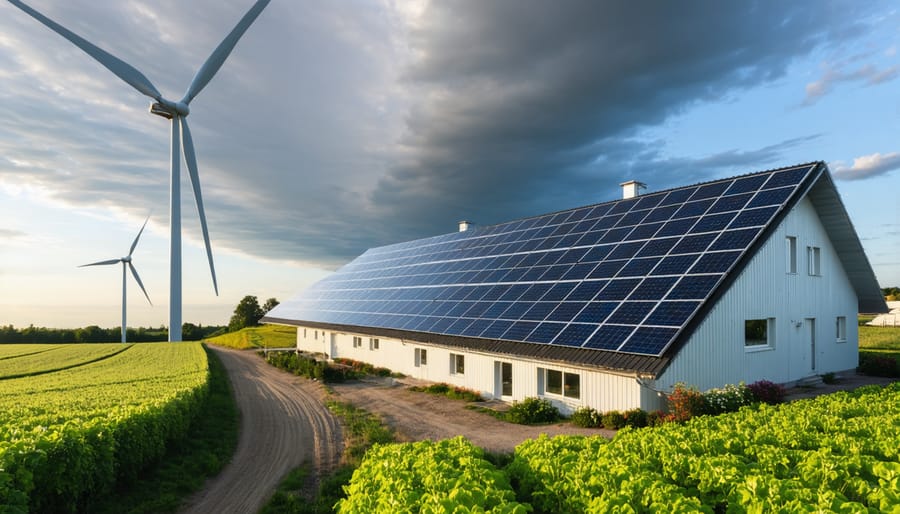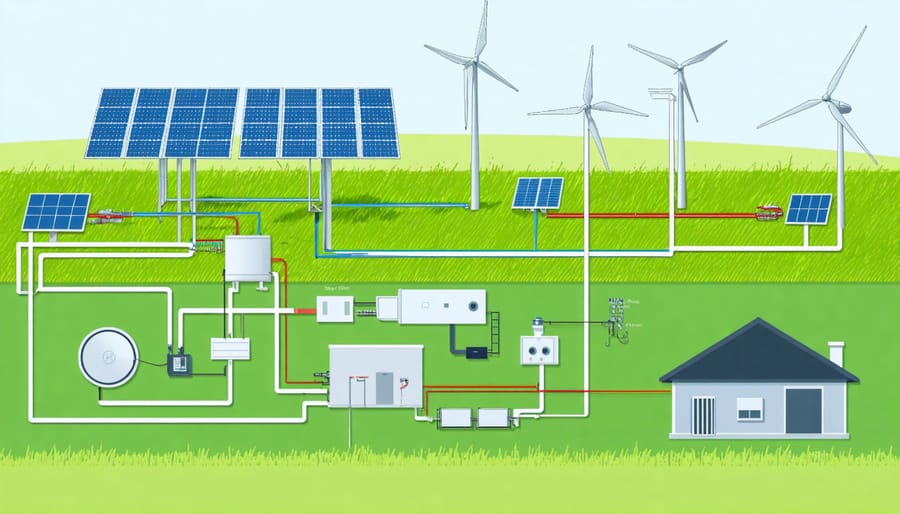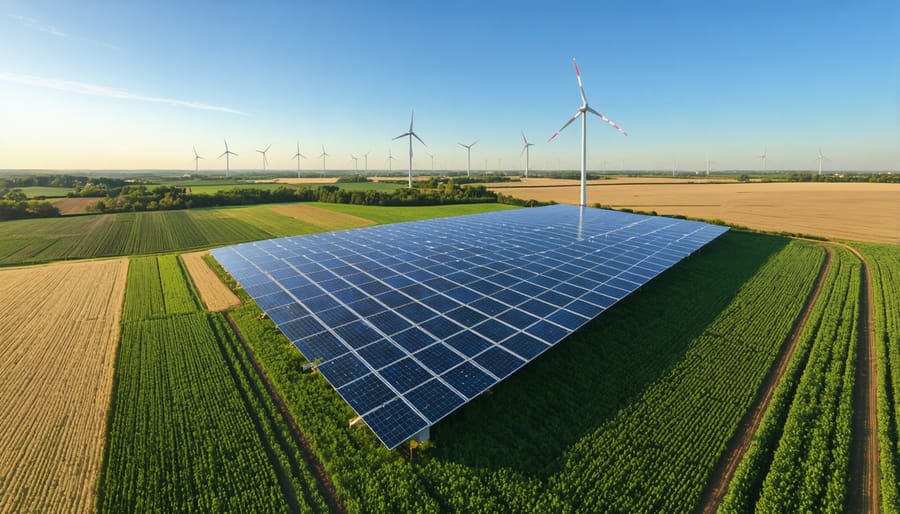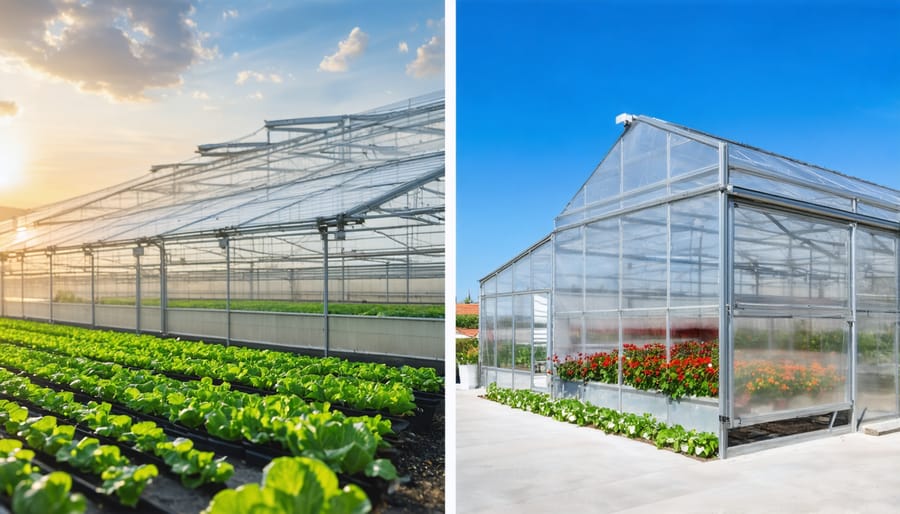Hybrid Solar-Wind Systems Are Revolutionizing European Agriculture

Harness nature’s dual power sources through innovative hybrid solar-wind systems that revolutionize sustainable energy generation across European landscapes. This integrated approach combines solar panels’ daytime efficiency with wind turbines’ round-the-clock potential, delivering up to 35% more energy than standalone installations. By synchronizing these complementary technologies, property owners achieve consistent power output throughout seasonal variations, significantly reducing reliance on grid electricity.
Modern hybrid systems have evolved beyond simple component combination, incorporating smart grid technology and advanced energy storage solutions that maximize power generation while minimizing installation footprint. In regions like Germany and Denmark, where weather patterns fluctuate dramatically, these systems demonstrate remarkable resilience, maintaining steady energy production through diverse atmospheric conditions.
For European agricultural operations and residential properties, hybrid installations offer a compelling solution to energy independence, typically achieving return on investment within 6-8 years while contributing to the EU’s renewable energy targets. This innovative approach to sustainable power generation represents the future of decentralized energy production, combining proven technologies with cutting-edge energy management systems.
Understanding Hybrid Solar-Wind Systems in Agriculture
Components and Integration
A hybrid solar-wind system combines multiple components that work in harmony to deliver reliable renewable energy. The core elements include solar panels, wind turbines, and advanced energy storage solutions. The solar array typically consists of photovoltaic panels mounted on rooftops or ground-mounted structures, while wind turbines are positioned to capture optimal wind resources.
The system’s brain is the hybrid controller, which manages power flow between different components. It continuously monitors energy production, consumption, and storage levels, making real-time decisions to optimize system performance. Inverters convert DC power from solar panels and wind turbines into AC power suitable for household use.
Battery banks store excess energy for use during low production periods, while grid-tie systems enable power exchange with the main electrical grid when needed. Smart meters and monitoring systems provide real-time data on energy production and consumption, allowing users to track performance and adjust usage patterns accordingly. The integration of these components creates a resilient energy system that maximizes renewable resource utilization while ensuring consistent power supply.

Agricultural Energy Requirements
Modern agricultural operations require significant energy input for various activities, from irrigation systems and climate-controlled greenhouses to cold storage facilities and processing equipment. A typical European farm consumes between 50,000 to 150,000 kWh annually, depending on its size and specialisation.
Hybrid solar-wind systems are particularly well-suited for agricultural applications due to their complementary nature. While solar panels provide peak power during daylight hours for irrigation and cooling needs, wind turbines can continue generating electricity during nighttime and cloudy conditions, ensuring consistent power for essential operations like cold storage and automated systems.
These hybrid systems effectively address the seasonal variations in agricultural energy demands. During summer months, when irrigation needs are highest, solar generation peaks, while stronger winds during winter months support heating requirements for livestock buildings and greenhouses. This natural alignment with farming cycles makes hybrid systems especially valuable for agricultural operations.
The scalability of hybrid systems allows farmers to match their specific energy requirements, whether for small family farms or large commercial operations, while contributing to sustainable agriculture practices and reduced operational costs.
Key Benefits for European Farmers
Energy Independence and Cost Savings
Hybrid solar-wind systems offer a compelling path to energy independence while delivering substantial cost savings over time. By combining two renewable energy sources, these systems provide more consistent power generation throughout the day and across seasons, enabling significant reduced grid dependency for European households and businesses.
The financial benefits are particularly noteworthy. Initial installation costs are offset by decreased energy bills, with many system owners reporting 60-80% reductions in grid electricity consumption. Government incentives and feed-in tariffs across European countries further enhance the economic appeal, often resulting in return on investment within 6-8 years.
Energy independence brings additional value beyond direct cost savings. Protection against rising electricity prices, which have increased by an average of 13% annually in Europe, ensures long-term financial stability. During peak demand periods, when grid electricity costs are highest, hybrid systems can often generate surplus power, allowing owners to benefit from feed-in tariff rates.
The system’s dual-generation capability also provides enhanced energy security. While solar panels produce power during daylight hours, wind turbines can generate electricity day and night, weather permitting. This complementary generation pattern ensures more reliable power supply and reduces the need for expensive energy storage solutions, contributing to overall system cost-effectiveness.
Year-Round Reliability
One of the most compelling advantages of hybrid solar-wind systems is their ability to provide consistent power throughout the year. While individual solar and wind resources naturally fluctuate with weather patterns and seasonal changes, their complementary nature creates a remarkably reliable energy generation profile.
During summer months, longer daylight hours and intense sunshine maximize solar panel output, compensating for typically lower wind speeds. Conversely, winter periods often bring stronger winds and increased turbine productivity, offsetting reduced solar generation due to shorter days and cloud cover. This natural balance helps maintain steady power production across seasons.
The system’s reliability is particularly evident in European climates, where seasonal variations are pronounced. For instance, in countries like Germany and Denmark, wind energy typically peaks during autumn and winter months, precisely when solar production decreases. During spring and summer, the pattern reverses, ensuring consistent energy availability.
Modern smart controllers further enhance this reliability by automatically switching between energy sources based on real-time conditions. When combined with energy storage solutions, these systems can maintain stable power supply even during extended periods of unfavorable weather, making them increasingly attractive for both residential and commercial applications seeking energy independence.
Implementation and System Design
Site Assessment and Planning
Successful implementation of a hybrid solar-wind system begins with thorough site assessment and careful planning. The first crucial step involves evaluating the location’s solar and wind resources through detailed meteorological data analysis. This includes studying annual solar irradiance patterns, seasonal wind speeds, and directional variations throughout the year.
Topographical features play a vital role in system efficiency. The ideal site should have minimal obstacles that could cast shadows on solar panels or disrupt wind flow. For wind turbines, elevated areas with consistent wind patterns are preferred, while solar panels require unobstructed southern exposure in the Northern Hemisphere.
Space availability and structural considerations must be carefully evaluated. Roof integrity assessment for solar panel installation and soil stability analysis for wind turbine foundations are essential. Local building codes, zoning regulations, and environmental impact assessments must also be considered, particularly in densely populated European regions.
Grid connection capabilities need thorough assessment. This includes evaluating the local power infrastructure’s capacity to handle feed-in power and determining whether upgrades are necessary. The distance to the nearest grid connection point can significantly impact installation costs.
Financial planning should encompass both immediate installation costs and long-term considerations such as maintenance requirements, insurance, and potential incentive schemes available in your region. Many European countries offer specific support programmes for hybrid renewable energy systems.
A comprehensive feasibility study should also consider potential noise impacts, visual effects on the landscape, and wildlife protection measures, especially in rural or protected areas. Working with experienced renewable energy consultants can help ensure all critical factors are properly evaluated and addressed in the planning phase.
Integration with Existing Farm Infrastructure
Integrating hybrid solar-wind systems into existing farm infrastructure requires careful planning and consideration of the farm’s unique layout and operational needs. The key is to maximize energy production while minimizing disruption to agricultural activities.
Most modern farms already have suitable infrastructure elements that can support hybrid installations. Existing barn roofs often provide ideal surfaces for solar panels, while open fields or elevated areas present excellent opportunities for wind turbine placement. The electrical infrastructure typically present on farms, including transformers and power lines, can usually be adapted to accommodate the new system with minimal modifications.
Storage solutions, such as battery banks, can be housed in existing farm buildings, protecting them from the elements while maintaining easy access for maintenance. Smart monitoring systems can be integrated into the farm’s existing internet infrastructure, allowing farmers to track energy production and consumption alongside other agricultural management systems.
When planning the integration, consider:
– Available roof space and structural integrity of buildings
– Field layouts and crop rotation patterns
– Access routes for maintenance vehicles
– Proximity to existing electrical infrastructure
– Location of water sources and irrigation systems
– Seasonal farming activities and equipment movement
Many European farmers have successfully implemented hybrid systems by utilizing field margins and less productive areas for wind turbines, while mounting solar panels on equipment sheds and livestock buildings. This approach maintains valuable agricultural land while creating new revenue streams through energy generation.
To ensure smooth integration, work with experienced installers who understand agricultural operations and can design systems that complement rather than compete with farming activities. Modern installation techniques minimize ground disturbance and can often be completed during off-peak farming periods.

Real-World Success Stories
Mediterranean Greenhouse Operations
A remarkable success story in hybrid solar-wind implementation comes from southern Spain’s Mediterranean coast, where a network of commercial greenhouses has transformed their energy consumption patterns. In 2019, a consortium of greenhouse operators implemented an integrated hybrid solar-wind system across 15 hectares of growing space, demonstrating the powerful synergy between renewable energy and modern agriculture.
The system combines 2.5 MW of solar panels installed on greenhouse roofs with three 850 kW wind turbines strategically positioned to capture prevalent coastal winds. This configuration not only powers essential greenhouse operations but also supports advanced climate control systems, irrigation pumps, and LED growing lights during lower light conditions.
Initial results have exceeded expectations, with the hybrid system meeting 85% of the greenhouses’ total energy requirements. During peak summer months, excess energy is fed back into the local grid, creating an additional revenue stream for operators. The system has reduced operational costs by 62% compared to traditional grid power, with a projected return on investment period of just six years.
Particularly noteworthy is the system’s role in maintaining optimal growing conditions throughout the year. The combination of solar and wind power ensures reliable energy supply during both day and night, critical for maintaining consistent temperature and humidity levels for high-value crops like tomatoes and peppers.

Northern European Dairy Farms
In the challenging climate of Northern Europe, dairy farms have emerged as pioneers in hybrid solar-wind system implementation, demonstrating remarkable success in achieving year-round energy reliability. A notable example is the Bergström Farm in southern Sweden, which installed a comprehensive hybrid system in 2019, combining 150kW of solar panels with two 50kW wind turbines.
The farm’s hybrid system has proven particularly effective in managing seasonal variations. During summer months, the solar components generate surplus energy, while the wind turbines maintain consistent output during darker winter periods. This complementary relationship ensures stable power supply throughout the year, with the farm reporting 92% energy self-sufficiency in its first year of operation.
The success has sparked a regional movement, with over 30 dairy farms across Denmark, Sweden, and Finland adopting similar systems. These installations have demonstrated average energy cost reductions of 65% while maintaining reliable power for critical operations like milking machines, refrigeration units, and automated feeding systems.
The most compelling aspect is the system’s resilience during extreme weather events. During the severe winter storms of 2021, farms with hybrid systems maintained operations without interruption, while conventional grid-dependent facilities experienced significant downtime. This reliability factor has made hybrid systems increasingly attractive to agricultural operations across Northern Europe, with installation rates growing by 40% annually since 2020.
Hybrid solar-wind systems represent a transformative solution for European agricultural operations, offering a robust path toward energy independence and sustainability. By combining the complementary nature of solar and wind resources, these systems provide more consistent power generation throughout the year, addressing the variable energy demands of modern farming operations.
The evidence is compelling: farms implementing hybrid systems typically see 30-40% higher overall energy production compared to single-source renewable solutions. This increased reliability, coupled with significant cost savings and reduced carbon footprint, makes hybrid systems an attractive investment for forward-thinking agricultural businesses.
For farmers considering this technology, the next steps are clear. Begin with a comprehensive site assessment to evaluate your farm’s solar and wind potential. Consult with certified renewable energy specialists who understand agricultural applications and can provide tailored solutions. Investigate available EU and national-level incentives, which can substantially reduce initial investment costs.
Consider starting with a pilot project on a smaller scale to understand system dynamics and optimize performance for your specific needs. Connect with local farming associations and renewable energy networks to learn from others’ experiences and share best practices.
The future of sustainable agriculture in Europe increasingly points toward integrated energy solutions like hybrid solar-wind systems. By taking action today, farmers can position themselves at the forefront of agricultural innovation while contributing to Europe’s renewable energy goals.
Leave a Reply